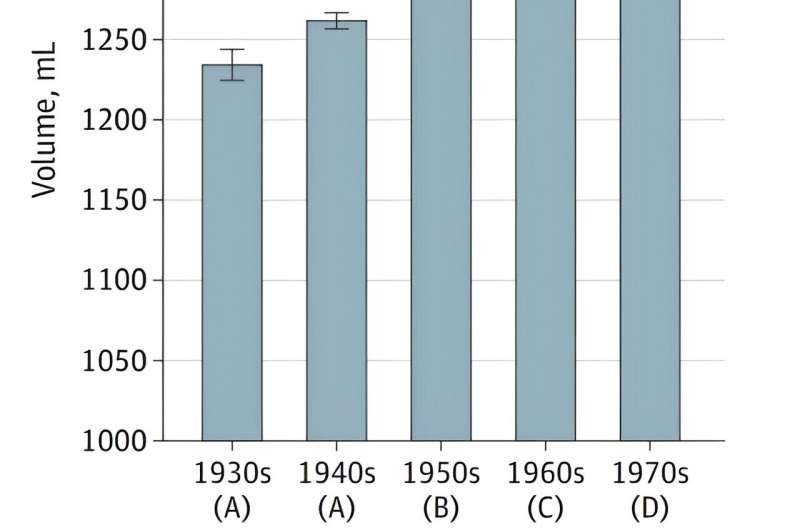This article has been reviewed according to Science X's editorial process and policies. Editors have highlighted the following attributes while ensuring the content's credibility:
fact-checked
peer-reviewed publication
trusted source
proofread
Human brains are getting larger: That may be good news for dementia risk

A new study by researchers at UC Davis Health found human brains are getting larger. Study participants born in the 1970s had 6.6% larger brain volumes and almost 15% larger brain surface area than those born in the 1930s.
The researchers hypothesize the increased brain size may lead to an increased brain reserve, potentially reducing the overall risk of age-related dementias.
The findings were published in JAMA Neurology.
"The decade someone is born appears to impact brain size and potentially long-term brain health," said Charles DeCarli, first author of the study. DeCarli is a distinguished professor of neurology and director of the UC Davis Alzheimer's Disease Research Center. "Genetics plays a major role in determining brain size, but our findings indicate external influences—such as health, social, cultural and educational factors—may also play a role."
75-year study reveals brain changes between generations
The researchers used brain magnetic resonance imaging (MRIs) from participants in the Framingham Heart Study (FHS). The community-based study was launched in 1948 in Framingham, Massachusetts, to analyze patterns of cardiovascular and other diseases. The original cohort consisted of 5,209 men and women between the ages of 30 and 62. The research has continued for 75 years and now includes second and third generations of participants.
The MRIs were conducted between 1999 and 2019 with FHS participants born during the 1930s through the 1970s. The brain study consisted of 3,226 participants (53% female, 47% male) with an average age of about 57 at the time of the MRI.
The research led by UC Davis compared the MRIs of people born in the 1930s to those born in the 1970s. It found gradual but consistent increases in several brain structures. For example, a measure that looked at brain volume (intracranial volume) showed steady increases decade by decade. For participants born in the 1930s, the average volume was 1,234 milliliters, but for those born in the 1970s, the volume was 1,321 milliliters, or about 6.6% greater volume.
Cortical surface area—a measure of the brain's surface—showed an even greater increase decade by decade. Participants born in the 1970s had an average surface area of 2,104 square centimeters compared to 2,056 square centimeters for participants born in the 1930s—almost a 15% increase in volume.
The researchers found brain structures such as white matter, gray matter and hippocampus (a brain region involved in learning and memory) also increased in size when comparing participants born in the 1930s to those born in the 1970s.
Larger brains may mean lower incidence of dementia
According to the Alzheimer's Association, approximately 7 million Americans are currently living with Alzheimer's disease. That number is expected to rise to 11.2 million by 2040.
Although the numbers are rising with America's aging population, the incidence of Alzheimer's—the percentage of the population affected by the disease—is decreasing. A previous study found a 20% reduction in the incidence of dementia per decade since the 1970s.
Improved brain health and size may be one reason why.
"Larger brain structures like those observed in our study may reflect improved brain development and improved brain health," DeCarli said. "A larger brain structure represents a larger brain reserve and may buffer the late-life effects of age-related brain diseases like Alzheimer's and related dementias."
One of the study's strengths is the design of the FHS study, which allows the researchers to examine brain imaging of three generations of participants with birthdates spanning almost 80 years. A limitation is that non-Hispanic white participants make up the majority of the FHS cohort, which is not representative of the U.S. population.
More information: Charles DeCarli et al, Trends in Intracranial and Cerebral Volumes of Framingham Heart Study Participants Born 1930 to 1970, JAMA Neurology (2024). DOI: 10.1001/jamaneurol.2024.0469




















